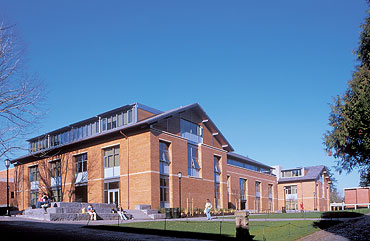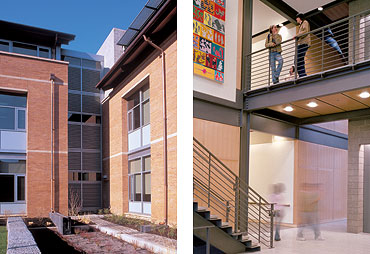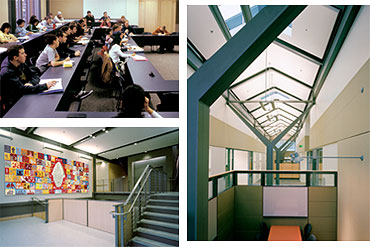Howard Hall Joins the Academic Quad
Open gallery

Over winter break, more than 50 faculty and staff members moved into John R. Howard Hall, located at the heart of the academic campus. Named in honor of John R. Howard, president emeritus and life trustee, the three-story building provides more than 50,000 square feet of academic space, including state-of-the-art classrooms and faculty offices, instructional space ranging from large lecture halls to intimate seminar rooms, and attractive public spaces.
Howard Hall is a center for disciplines related to societal inspection: economics, political science, sociology and anthropology, communication, international affairs, gender studies, environmental studies, religious studies, and philosophy. Intended to serve as a “town square” for the College community, Howard Hall supports collaborative interdisciplinary teaching, research, student recruitment, and camaraderie among faculty, students, and staff.
Howard Hall sets a new standard for energy efficiency and adaptability in the College’s use of “green” architectural materials to minimize the building’s ecological impact. With its long list of green features, Howard Hall has a chance to receive Gold certification from the U.S. Green Building Council’s LEED program. Appropriately, Howard Hall will be officially dedicated on Earth Day, April 22.

Above, left: The building’s storm water filtration, storage, and reuse system has already won accolades from the Oregon chapter of the American Society of Landscape Architects. Above, right: Howard Hall’s interior features—exposed steel, unpainted concrete blocks, and polished concrete floors—metaphorically represent how the social sciences reveal the rich inner character of society.
LEED Criteria
Sustainable Site Howard Hall has the same footprint as the buildings it replaces (the Faculty Offices building and the Thaxter, Throckmorton, and Edmonds classroom and office complex), but it gives the College three times more usable space.
Water Efficiency The building is designed to capture and filter storm water runoff from its roofs. Collected water will be used for irrigation across campus.
Energy and Atmosphere Howard Hall is designed to be about 40 percent more efficient than a conventional building of its size.
Materials and Resources Design and construction were planned to minimize resource depletion. Materials come from local sources wherever possible, and 50 percent of the building’s materials contain recycled content.
Indoor Environmental Quality The building’s design features promote the health of building occupants and enrich the learning environment. All classrooms and offices are daylit and include views; carpet, paint, sealants, and finishes are low-emitting materials; and a displacement ventilation system with a raised floor quietly enhances indoor air quality and maintains optimal room temperature.
Innovation and Design Process Faculty, staff, and students participated in four committees (building design, classroom design, program planning, and steering) to ensure that Howard Hall was designed to meet community needs. In addition, three classes used the project as a backdrop for learning: a hydrology class explored the capture and reuse of rainwater; an economics class examined the cost-effectiveness of water recycling; and an environmental studies class researched data and drafted text for construction site posters that explain the building’s green features.

Above, upper-left: The building’s flexible classroom layouts (with electrical and communication cabling beneath the raised floors) support modern scholarship yet anticipate evolving uses of technology. Each classroom in Howard Hall has network access for wireless-equipped laptops. Above, right: Sky and steel meet in the soaring ceiling of Howard Hall’s third floor, home to faculty offices. Above, lower-left: The building features a range of private and semipublic spaces, such as this expanded stair landing, to facilitate interaction among students and faculty. Mark R. Smith’s painting, An Intimate City,provides a colorful backdrop.
More L&C Magazine Stories
Lewis & Clark Magazine is located in McAfee on the Undergraduate Campus.
MSC: 19
email magazine@lclark.edu
voice 503-768-7970
fax 503-768-7969
The L&C Magazine staff welcomes letters and emails from readers about topics covered in the magazine. Correspondence must include your name and location and may be edited.
Lewis & Clark Magazine
Lewis & Clark
615 S. Palatine Hill Road MSC 19
Portland OR 97219

